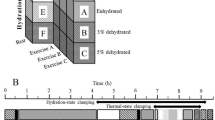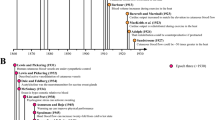Abstract
Polycythaemia has been shown to improve physical performance, possibly due to increased arterial oxygen transport. Enhanced thermoregulatory function may also accompany this manipulation, since a greater proportion of the cardiac output becomes available for heat dissipation. We further examined this possibility in five trained men, who participated in three-phase heat stress trials (20 min rest, 20 min cycling at 30% peak power Wpeak and 20 min at 45% Wpeak at 38.3 (SEM 0.7)°C [relative humidity 41.4 (SEM 2.9)%]. Trials were performed during normocythaemia (control) and polycythaemia, obtained by reinfusion of autologous red blood cells and resulting in significant elevation of arterial oxygen transport. During the polycythaemic trials, the subjects demonstrated diminished thermal strain, as evidenced by a significant reduction in cardiac frequency (f c: 12 beats · min−1 lower throughout the test;P < 0.05), and reduced auditory canal temperatures (T ae) during the latter 20-min phase (P < 0.05). Forearm sweat onset was more rapid (363.0 compared to 1083.0 s;P < 0.05), and forearm sweat rate (. msw) sensitivity was elevated from 1.80 to 2.91 · mg · cm−2 · min−1 · °C−1 (P < 0.05). Foreheadm sw was depressed during the final 20 min, while forearmm sw was greater during all test phases, averaging 0.94 and 1.20 mg · cm−2 · min−1, respectively, over the 60 min. Skin blood flows for the upper back, upper arm and forearm were reduced (P < 0.05). Polycythaemia enhanced thermoregulation, through an elevation in forearm sweat sensitivity and.m sw, but not via increased cutaneous blood flow. These modifications occurred simultaneously with decreases inf c andT ae, resulting in greater thermal tolerance.
Similar content being viewed by others
References
Balgos AA, Willford DC, West JB (1988) Ventilation-perfusion relationships during induced normovolemic polycythemia in dogs. J Appl Physiol 65:1686–1692
Borg GAV (1962) Physical performance and perceived exertion. Gleerup, Lund
Buick FJ, Gledhill N, Froese AB, Spriet L, Meyers EC (1980) Effect of induced erythrocythemia on aerobic capacity. J Appl Physiol 48:636–642
Celsing F, Nyström J, Pihlstedt P, Werner B, Ekbolm B (1986) Effects of long-term anemia and retransfusion on central circulation during exercise. J Appl Physiol 61:1358–1362
Cotter JD, Mark AJ, Regan JM, Taylor NAS (1993) Optimal sites for the measurement of human skin blood flow using laser Doppler velocimetry. Proc Aust Physiol Pharmacol Soc 24:184P
Cotter JD, Patterson MJ, Taylor NAS (1995) Topography of eccrine sweating in humans during exercise. Eur J Appl Physiol (in press)
Ekblom B, Goldbarg AN, Gullbring B (1972) Response to exercise after blood loss and reinfusion. J Appl Physiol 33:175–180
Ekblom B, Wilson G, Åstrand P-O (1976) Central circulation during exercise after venesection and reinfusion of red blood cells. J Appl Physiol 40:379–383
Fåhraeus R, Lindquist T (1931) The viscosity of the blood in narrow capillary tubes. Am J Physiol 96:562–568
Francesconi RP, Sawka MN, Dennis RC, Gonzalez RR, Young AJ, Valeri CR (1988) Autologous red blood cell reinfusion: effects on stress and fluid regulatory hormones during exercise in the heat. Aviat Space Environ Med 59:133–137
International Organisation for Standardization (1992) Evaluation of thermal strain by physiological measurements. ISO 9886:1992 [E] ISO, Geneva, Switzerland
Keatinge WR, Sloan REG (1975) Deep body temperature from aural canal with servo-controlled heating of the outer ear. J Appl Physiol 38:919–921
Klein HG (1985) Blood transfusion and athletics. N Eng J Med 312:854–856
Koller A, Sun D, Kaley G (1993) Role of shear stress and endothelial prostoglandins in flow- and viscosity-induced dilation of arterioles in vitro. Circ Res 72:1276–1284
Maw GJ, Boutcher SB, Taylor NAS (1993) Ratings of perceived exertion and affect in hot and cool environments. Eur J Appl Physiol 67:174–179
Nadel ER, Pandolf KB, Roberts MF, Stolwijk JAJ (1974) Mechanisms of thermal acclimation to exercise and heat. J Appl Physiol 37:515–520
Oscai L, Williams B, Hertig B (1968) Effect of exercise on blood volume. J Appl Physiol 24:622–624
Pace N, Lozner EL, Consolazio WV, Pitts GC, Pecora LJ (1947) The increase in hypoxia tolerance of normal men accompanying the polycythemia induced by the transfusion of erythrocytes. Am J Physiol 148:152–163
Patterson MJ, Warlters D, Taylor NAS (1994) Attenuation of the cutaneous blood flow response during combined exercise and thermal stress. Eur J Appl Physiol 69:367–369
Regan JM, Macfarlane DJ, Taylor NAS (1994) Adaptation to heat: differences induced by isothermal strain following heat acclimation and thermoneutral exercise. Proc Aust Physiol Pharmacol Soc 25:3P
Richardson TQ, Guyton AC (1959) Effects of polycythemia and anemia on cardiac output and other circulatory factors. Am J Physiol 197:1167–1170
Robertson RJ, Gilcher R, Metz KF, Caspersen CJ, Allison TG, Abbott RA, Skrinar GS, Krause JR, Nixon PA (1984) Hemoglobin concentration and aerobic work capacity in women following induced erythrocythemia J Appl Physiol 57:568–575
Sawka MN, Young AJ (1989) Acute polycythemia and human performance during exercise and exposure to extreme environments. Exerc Sport Sci Rev 17:265–293
Sawka MN, Dennis RC, Gonzalez RR, Young AJ, Muza SR, Martin JW, Werner CB, Francesconi RP, Pandolf KB, Valeri CR (1987) Influence of polycythaemia on blood volume and thermoregulation during exercise-heat stress. J Appl Physiol 62:1165–1169
Sawka MN, Gonzalez RR, Young AJ, Muza SR, Pandolf KB, Latzka WA, Dennis RC, Valeri CR (1988) Polycythaemia and hydration: effects on thermoregulation and blood volume during exercise-heat stress. Am J Physiol 255:R456-R463
Somer T, Meiselman HJ (1993) Disorders of blood visocity. Ann Med 25:31–39
Spriet LL, Gledhill N, Froese AB, Wilkes DL (1986) Effect of graded erythrocythemia on cardiovascular and metabolic responses to exercise. J Appl Physiol 61:1942–1948
Stone HO, Thompson HK, Schmidt-Nielsen K (1968) Influence of erythrocytes on blood viscosity. Am J Physiol 214:913–918
Author information
Authors and Affiliations
Rights and permissions
About this article
Cite this article
Patterson, M.J., Cotter, J.D. & Taylor, N.A.S. Thermal tolerance following artificially induced polycythaemia. Europ. J. Appl. Physiol. 71, 416–423 (1995). https://doi.org/10.1007/BF00635875
Accepted:
Issue Date:
DOI: https://doi.org/10.1007/BF00635875




